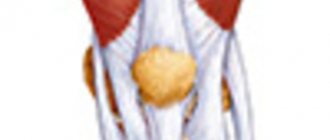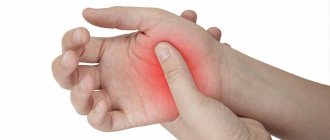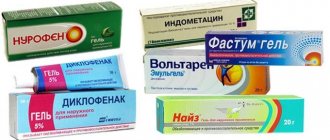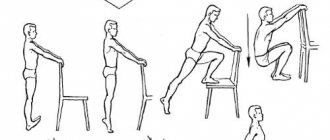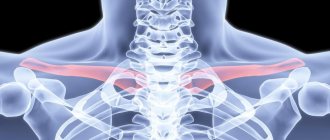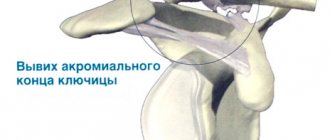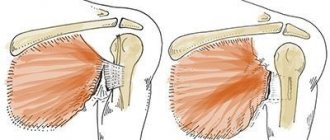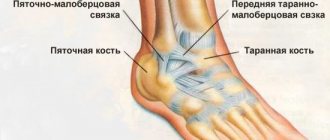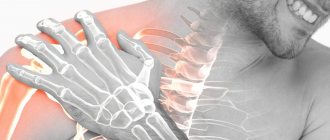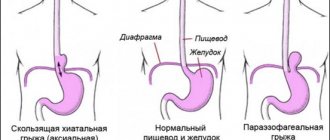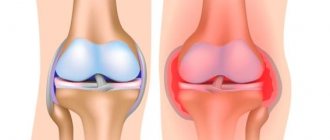Brachial plexus lesions
The brachial plexus includes : axillary nerve (nervus axillaris), musculocutaneous nerve (nervus musculocutaneus), radial nerve (nervus radialis), ulnar nerve (nervus ulnaris), median nerve (nervus medialis). The anterior branches of the four lower cervical nerves and two upper thoracic nerves take part in the formation of the brachial plexus (plexus brachialis). The brachial plexus has two parts: supraclavicular and subclavian. The nerves that form the brachial plexus innervate the muscles of the shoulder girdle and upper limb. The anterior branches of the thoracic nerves do not participate in the formation of the brachial plexus. They form intercostal nerves that innervate the intercostal muscles, the levator ribs, and the abdominal muscles.
CLINICAL PICTURE
As a result of exposure to various etiological factors, damage to the entire brachial plexus, or its supraclavicular or subclavian part, is possible. The first place among the etiological factors contributing to the development of brachial plexitis is given to infections such as influenza, syphilis, typhus, and brucellosis. Brachial plexitis can be caused by other diseases, in particular gout, diabetes, alcoholism, etc. Injuries, such as shoulder dislocation, injury are also among the etiological factors of damage to the brachial plexus. Damage to the supraclavicular part of the brachial plexus (Duchenne-Erb palsy).
With this pathology, the axillary nerve, musculocutaneous nerve, and radial nerve are affected. In this case, the function of all of the above nerves, as well as the muscles receiving innervation from them, occurs. These muscles are the deltoid, biceps, brachialis, brachioradialis, and supinator. In case of damage to the supraclavicular part of the brachial plexus, abduction of the affected arm, elevation to the horizontal line and adduction to the face are impaired. There is a loss of the flexion-ulnar tendon reflex from the biceps brachii muscle, upon palpation there is a sharp pain in the area of the supraclavicular fossa, all types of sensitivity on the skin of the shoulder girdle are impaired. The muscles of the forearm and hand retain their functional ability.
When the subclavian part of the cervical plexus is damaged, Dejerine-Klumpke palsy develops. The cause of paralysis is dysfunction of the ulnar, radial and median nerves. This leads to movement disorders in the forearm, hand and fingers. There is a disappearance of tendon and periosteal reflexes in the upper limb. On palpation, sharp pain is noted in the area of the subclavian fossa, radiating throughout the arm. In addition, there is a violation of all types of sensitivity on the inner surface of the shoulder, forearm and hand of the radicular type.
SYMPTOMS
Damage to the entire brachial plexus is characterized by the following clinical manifestations:
- paralysis of the muscles of the entire upper limb of a peripheral nature
- periosteal and tendon reflexes decrease or disappear
- persistent pain appears that spreads throughout the arm
- in the zone of innervation of the brachial plexus nerves, all types of sensitivity are impaired
TREATMENT
Treatment should be carried out exclusively by a neurologist. Self-medication is unacceptable.
Brachial plexitis
Differentiated therapy is determined by the genesis of plexitis. According to indications, antibiotic therapy, antiviral treatment, immobilization of the injured shoulder joint, removal of hematoma or tumor, detoxification, and correction of metabolic disorders are carried out. In some cases (usually with obstetric paralysis), a joint decision with a neurosurgeon is required on the advisability of surgical intervention - plastic surgery of the nerve trunks of the plexus.
The general direction of treatment is vasoactive and metabolic therapy, which provides improved nutrition and, therefore, faster restoration of nerve fibers. Patients with brachial plexitis receive pentoxifylline, complex preparations of B vitamins, nicotinic acid, and ATP. Some physiotherapy procedures are also aimed at improving the trophism of the affected plexus - electrophoresis, mud therapy, thermal procedures, massage.
Of no small importance is given to symptomatic therapy, including relief of plexalgia. Patients are prescribed NSAIDs (diclofenac, metamizole sodium, etc.), therapeutic blockades with novocaine, hydrocortisone ultraphonophoresis, UHF, reflexology. To support muscles, improve blood circulation and prevent contractures of the joints of the affected arm, a special complex of exercise therapy and massage of the upper limb is recommended. During the recovery period, repeated courses of neurometabolic therapy and massage are carried out, exercise therapy is continuously carried out with a gradual increase in load.
Prognosis and prevention
Timely initiation of treatment, successful elimination of the causative trigger (hematoma, tumor, injury, infection, etc.), adequate restorative therapy usually contribute to the complete restoration of the function of the nerves of the affected plexus. If the start of therapy is delayed and the influence of the causative factor cannot be completely eliminated, brachial plexitis does not have a very favorable prognosis in terms of recovery. Over time, irreversible changes occur in muscles and tissues caused by their insufficient innervation; muscle atrophy and joint contractures are formed. Since the dominant hand is most often affected, the patient loses not only his professional capabilities, but also his ability to self-care.
Measures to prevent brachial plexitis include injury prevention, adequate choice of method of delivery and professional management of childbirth, compliance with surgical techniques, timely treatment of injuries, infectious and autoimmune diseases, and correction of dysmetabolic disorders. Maintaining a normal regimen, healthy physical activity, and proper nutrition helps increase the resistance of nerve tissue to various adverse effects.
Treatment of shoulder plexitis
Conservative treatment for brachial plexitis is complex and includes:
- drug therapy;
- massage, osteopathy;
- physiotherapy;
- various types of electrotherapy;
- cryo- and laser therapy;
- balneological treatment
; - reflexology and hirudotherapy;
- physical therapy.
For drug therapy of the disease, doctors prescribe modern, highly effective drugs:
- analgesics;
- anti-inflammatory agents;
- drugs to improve blood circulation;
- agents that restore nerve conduction;
- vitamins (B1, B12).
If there is such a need, specific medications can be used.
Anti-inflammatory therapy is one of the main components of the treatment of plexitis of the shoulder joint. Non-steroidal medications are used as anti-inflammatory agents, which not only prevent the development of the inflammatory process in the nervous tissue, but also relieve pain. These drugs can be prescribed either in the form of tablets or injection solutions, or in the form of ointments and creams.
If the inflammatory process is severe, the use of hormonal medications may be prescribed that effectively fight inflammation and accelerate the process of tissue repair.
Symptoms
Signs and symptoms of a brachial plexus injury vary widely, depending on the severity and location of the injury. Usually only one hand is affected.
Minor injuries
Minor injuries, which are nerve sprains, usually occur during contact sports such as football or wrestling. The following symptoms are typical for these injuries:
- Feeling like an electric shock or burning sensation that radiates to the arm
- Numbness and weakness of the arm
- Symptoms usually last a few seconds or minutes, but in some patients they may last for several days or longer.
More severe injuries
More severe symptoms usually occur when nerves are cut or ruptured. The most severe injury to the brachial plexus is avulsion, that is, the separation of the nerve root from the spinal cord.
Signs and symptoms of more severe injuries include:
- Ability to move fingers, but loss of control of shoulder and elbow muscles
- Ability to control the hand but not the fingers
- Complete loss of control of the arm, including the elbow and hand
- Severe pain
Conditions under which you need to see a doctor
Severe injury to the brachial plexus can be disabling. Even if the injury does not seem serious, you should consult a doctor. You should consult a doctor if:
- Occasional burning or tingling occurs
- Weakness in the arm or hand
- Weakness anywhere in the arm after injury
- Pain in the neck
- Spread of symptoms to both arms
- Spread of symptoms to arms and legs
SHOULDER PAIN AFTER INJURY
Severe neuropathic pain syndrome of the shoulder is a rare but potentially dangerous complication of traumatic injuries to the extremities. It is one of the specific areas of treatment for chronic pain.
Avulsion of the nerve plexus is a traumatic preganglionic separation of the branches of the plexus (see Fig. 1).
Fig.1. Avulsion of the brachial plexus.
Severe pain can develop with avulsion of a nerve root at any level, but the most important clinical significance is avulsion of the nerve plexus (usually the brachial plexus), which is accompanied by severe pain in the insensitive limb. Chronic pain in the shoulder after injury with constant burning sensations and paroxysmal exacerbations develops with avulsion of the brachial plexus in 26-91% of cases. Pain may appear immediately after the traumatic injury or several months later. One study found that approximately one third of patients still had severe pain two years after injury. Stress, concomitant diseases, weather changes contribute to increased pain; in some cases, discomfort is relieved by traction or special techniques, such as squeezing or rocking the arm, or massaging the neck or shoulder. The limb is partially or completely devoid of sensitivity, but phantom-like sensations, paresthesia (tingling, burning, numbness) and others may be noted.
Differential diagnosis of nerve root damage and its avulsion is important, since in the first case nerve replacement is indicated. Typically, the diagnosis is made on the basis of cumulative clinical signs, electrodiagnostic studies and computer diagnostic results (the most important is magnetic resonance imaging, which can detect pseudomeningocele with root avulsion).
Comprehensive treatment for shoulder pain after injury aims to simultaneously relieve pain and restore function. The use of antidepressants and anticonvulsants plays an important role here. However, along with this, great importance is also attached to motor rehabilitation.
A special role in this pathology is played by surgical treatment - destruction of the dorsal root entry zone into the spinal cord (from the English Dorsum Root Entry Zone - DREZ operation).
Fig.2. Micro- DREZ -tomy.
It is necessary to take into account the fairly large percentage of complications of this operation, as well as the structure of these complications, among which the recurrence of the pain syndrome (often in an even more severe version) is perhaps the least dangerous in comparison with such complications as paresis, paralysis and dysfunction of the pelvic organs.
The initial version of this operation was extremely traumatic. In modern neurosurgery, the use of DREZ-tomy itself has already been abandoned and the so-called micro-DREZ-tomy is mainly used (see Fig. 2). The purpose of the operation is the destruction of only nociceptive fibers, i.e. conducting only pain impulses to the brain.
The operation itself is minimally invasive and is no longer performed with a scalpel, but with a laser knife, which significantly reduces trauma and the development of subsequent complications.
However, the accumulated clinical experience allows us to recommend its implementation only in cases of very intense pain.
With the advent of a new theory of the development of pain syndromes and new treatment methods, it has become possible to control pain during brachial plexus avulsion using neurostimulation methods. These include spinal cord stimulation and stimulation of the motor cortex of the brain. According to foreign literature, these methods have good efficiency (from 60% to 80%) and are minimally invasive; in addition, it is possible to test their effectiveness by test stimulation. To stimulate the spinal cord, this is percutaneous implantation of test electrodes, and to stimulate the motor cortex of the brain, this is transcranial magnetic stimulation. A more detailed description of these methods is provided in the relevant sections. Here it should be noted once again that these techniques are minimally invasive, and therefore have fewer complications, compared even with micro DREZ surgery.
In our clinic, spinal cord and brain stimulation has been used for the treatment of chronic pain syndromes for more than 10 years. You can make an appointment with us and get a comprehensive consultation on this issue. Your doctor E. D. Isagulyan is a candidate of medical sciences, an experienced neurosurgeon and algologist.
Complications
Over time, most brachial plexus injuries in adults and children heal without permanent damage. However, some injuries can cause temporary or permanent impairment:
Joint stiffness. When an arm or hand is paralyzed, joint stiffness may occur, limiting joint movement even though control of the limb has been restored. To achieve this, doctors usually prescribe physical therapy classes during the recovery period. Pain. The pain occurs due to nerve damage and can become chronic. Loss of sensation. If you lose sensation in your arm or hand, there is a risk of accidentally injuring or burning it and not noticing it. Muscular atrophy. Nerves recover slowly, taking several years. During this time, muscles that are not subjected to sufficient stress can atrophy. Irreversible damage. The extent of recovery from a brachial plexus injury depends on a number of factors, including age, type, location, and severity of the injury. Even after surgery, some patients experience irreversible damage, ranging from weakness in the hand, shoulder or forearm to paralysis.

